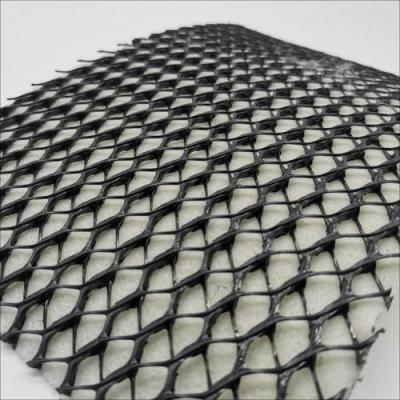Geocomposite drainage network It is a material commonly used in highways, railways, tunnels, landfills and other projects. It has excellent drainage performance, tensile strength and corrosion resistance, which can improve the stability of engineering structures and prolong the service life.
1. Overview of testing specification requirements
Geotechnical Composite drainage network The testing specification requirements involve many aspects, including appearance quality, material properties, physical and mechanical properties, and practical application effects. These specification requirements are designed to ensure that the geocomposite drainage network can maintain stable performance during production, transportation, installation and use, and meet the requirements of engineering design.
2. Appearance quality inspection
1、Mesh core color and impurities: The drainage mesh core is required to be uniform in color and free of variegation, bubbles and impurities. This is an important index to judge the purity of materials and the control level of production process.
2、Geotextile integrity: Check whether the geotextile is damaged and ensure that it is not damaged during transportation and installation, so as to maintain its complete waterproofing and drainage function.
3、Splicing and overlap: For the spliced drainage mesh core, check whether the splicing is smooth and firm; For overlapping geotextiles, ensure that the overlapping length meets the design requirements, generally not less than 10 cm。
3. Material performance testing
1、Resin density and melt flow rate: high-density polyethylene with drainage mesh core ( HDPE) Resin density should be greater than 0.94 g/cm³,Melt mass flow rate ( MFR) It is necessary to meet the standard requirements to ensure the strength and processability of the material.
2、Mass per unit area of geotextile: by GB/T 13762 Test the mass per unit area of geotextile according to other standards to ensure that it can meet the design requirements.
3、Tensile strength and tear strength: Test the longitudinal and transverse tensile strength and tear strength of geotextile to evaluate its breakage resistance.
4. Physical and mechanical properties testing
1、Longitudinal tensile strength: Test the longitudinal tensile strength of the drainage mesh core to ensure that it can maintain sufficient stability when under tension.
2、Longitudinal hydraulic conductivity: Test the longitudinal hydraulic conductivity of the drainage mesh core and evaluate whether its drainage performance meets the design requirements.
3、Peel strength: Test the peel strength between the geotextile and the drainage mesh core to ensure that the two can be tightly combined and prevent separation during use.
5. Practical application effect detection
In addition to the above laboratory tests, the application effect of geocomposite drainage network in practical projects should be tested. Including observing whether it has water leakage, deformation and other problems during use, and evaluating its influence on the stability of engineering structures through monitoring data.
It can be seen from the above that the testing specifications for geocomposite drainage networks cover many aspects such as appearance quality, material properties, physical and mechanical properties, and practical application effects. Strictly following these specifications can ensure that the quality and performance of geocomposite drainage network meet the requirements of engineering design, and provide a strong guarantee for the safety and reliability of the project.
Post time: Jan-03-2025




